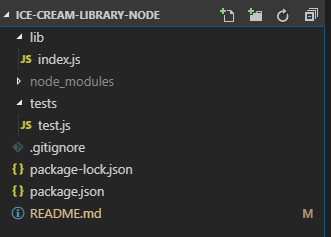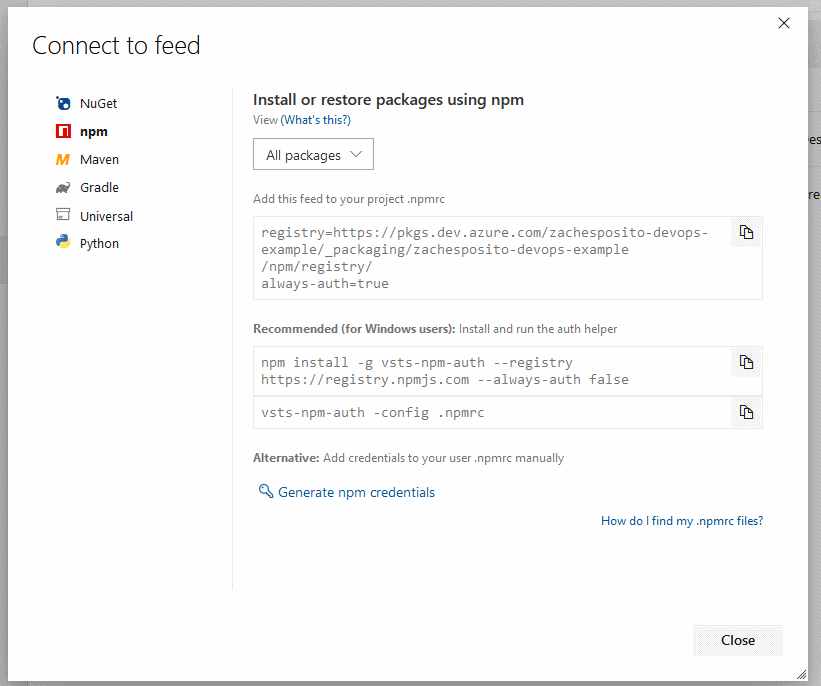Creating and sharing Node modules in a team
In my guide to creating NuGet packages for teams, I showed how to create a NuGet package and host it on a private NuGet feed using Azure DevOps, with the goal of enabling greater code reuse. Here’s how to do the same thing with Node.js modules:
Contents
- Create a Node module
- Create DevOps project and push code
- Create publish pipeline
- Consume feed
- Use module
- Releasing updates
- Conclusion
Create a Node module

As an example I re-implemented the Ice Cream Library from the NuGet guide as a Node module. You can clone it here.
Create a DevOps project and push code
Follow the same steps as shown in the NuGet guide.
Create publish pipeline
Follow the same steps as shown in the NuGet guide to select the ice-cream-library-node Git repository and the Starter pipeline template. On the Review your pipeline YAML step, replace the existing YAML with the following:
trigger:
- master
pool:
vmImage: 'ubuntu-latest'
steps:
- task: NodeTool@0
inputs:
versionSpec: '10.x'
displayName: 'Install Node.js'
- script: |
npm install
displayName: 'npm install'
- script: |
npm test
displayName: 'npm test'
- task: Npm@1
displayName: 'npm publish'
inputs:
command: publish
publishRegistry: useFeed
publishFeed: 'zachesposito-devops-example'The trigger and pool definitions are the same as the YAML from the Nuget guide. Here’s an outline of the steps in the above YAML:
Install Node.js
Install Node on the build machine using the Node installer task.
npm install
Uses the Command Line task to install dependencies.
npm test
Also uses the Command Line task to run tests (test script defined in package.json).
npm publish
Publishes this module to the private Artifacts feed. Note that this is the same feed that was used in the NuGet guide. An Azure Artifacts feed can contain multiple types of packages, in this case both NuGet packages and Node modules.
If the publishing step fails, try giving the project’s build account access to the Artifacts feed as described in the Troubleshooting section of the NuGet guide.
Consume feed
To make your development environment aware of the Artifacts feed so that you can npm install packages from it, follow these steps:
Add feed URL to .npmrc
On the Artifacts tab in the DevOps project, click Connect to feed and select npm on the left side:

Copy the contents of the first textbox and paste them into the .npmrc file located in your user folder. If .npmrc does not exist, create it.
Authenticate to feed
If developing on Windows, install the VSTS npm authentication helper tool: npm install -g vsts-npm-auth. Then, run the authentication helper to automatically add credentials to the .npmrc file: vsts-npm-auth -config path-to-your\.npmrc
If developing on another OS, generate a token to use in .npmrc.
Use module
Create another Node module to use the ice-cream-library-node module. In my case I reimplemented the very brief DessertBar project from the NuGet guide. After creating package.json, use npm install ice-cream-library-node --save to get the ice cream library module from the DevOps Artifacts feed.
After installing the ice cream library module, you can use it in code. Here’s index.js from the Node version of DessertBar:
const IceCreamServer = require('ice-cream-library-node');
const iceCreamService = new IceCreamServer();
const serving = iceCreamService.serve(2, 'chocolate');
console.log(`Served ${serving.scoops} scoops of ${serving.flavor} ice cream.`);Running node index.js should output Served 2 scoops of chocolate ice cream.
Releasing updates
Just like with NuGet packages, to release a new version, simply update the version property in package.json and then push a commit to the master branch in the DevOps repo. That will trigger the pipeline again and release a new version with the number you specified.
Conclusion
The above example showed how to create a simple Node module and publish it to a private Azure Artifacts feed using an automatic pipeline, and how to consume the module in another Node module. Now you can follow this pattern to make small, reusable Node modules for your team.